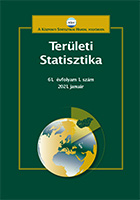A COVID-19-járvány első két hullámának területisége Közép-Európában
The spatiality of the first two wawes of the COVID-19 pandemic in Central-Europe
Author(s): Tamás Kovalcsik, Lajos Boros, Viktor PálSubject(s): Social Sciences, Economy, Geography, Regional studies
Published by: Központi Statisztikai Hivatal
Keywords: COVID-19; Central-Europe; spatial differences; pandemic
Summary/Abstract: The COVID-19 pandemic, emerging at the end of 2019, hit hard countries all over the world – including Central Europe. Nevertheless, both infection rates and fatalities have significant spatial differences. The aim of this paper is to reveal the spatial patterns of COVID-19 in Central Europe on various spatial scales. During the first wave in the spring of 2020 some of the countries encountered relatively low levels of infections and fatalities. The second wave of the pandemic caused significant health and health care problems in the whole region. The first wave hit Austria, Germany and Switzerland harder, and the dense urban agglomerations had the most outstanding concentrations of coronavirus infections. The spatiality of the pandemic changed during the second wave; the number of infections and fatalities grew in the Eastern countries of the region as well as in rural areas. By this token the second wave had a more severe effect on areas which were less affected before. The factors shaping these spatial processes are diverse and fluctuating over space and time, creating a complex spatial system of causes and consequences.
Journal: Területi Statisztika
- Issue Year: 62/2021
- Issue No: 03
- Page Range: 263-290
- Page Count: 28
- Language: Hungarian

